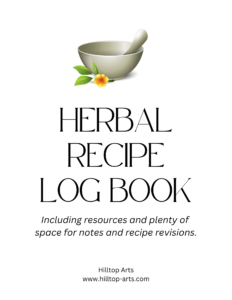Crafting Your Herbal Legacy: How to Build and Share a DIY Remedy Journal
If you’re an herbalist, this article will be helpful for you – about crafting your recipe book, your materia medica, or whatever you want to call the recipes you want to share or hand down. I’m adding in a link to my Herbal Recipe Logbook if you want to start your journal this way. Now, read on for Dylan’s excellent article.
You’ve filled your shelves with dried leaves and glass dropper bottles. You’ve tested your teas, your tinctures, and that oddly bitter root blend that somehow soothes your gut. But now what? For many herbalists, there comes a moment when you want to capture it all, not just for yourself, but for your future self, your friends, or the curious niece who keeps asking about the “sleepy tea.” Building a DIY herbal remedy guide or journal isn’t just about organizing recipes. It’s about preserving hard-earned knowledge, honoring tradition, and making space for your evolving craft. Here’s how to do it right, with room for both the roots and the wings.
Include a Range of Remedy Types
Think beyond teas. A good remedy journal doesn’t limit itself to infusions, but it embraces diversity. Record formulas for salves, syrups, oxymels, bath soaks, and even herbal vinegars. Separate internal and external uses, and clarify when a remedy is for acute relief versus ongoing tonics. This helps your journal reflect a full-spectrum practice that includes nourishing herbal infusions and glycerites in ways that are practical and deeply personal. If you’re new to formulating, keep it simple at first, then build. Start with blends for digestion, sleep, and minor skin irritations, and expand into seasonal immune supports or emotional allies like nervines.
Organize for Use and Gifting
You’re not just jotting notes — you’re building something functional. Divide your journal by body system, remedy type, or season, depending on how your brain works. Include checklists for commonly used ingredients, monthly harvest notes, or DIY label templates. You can even start with printable pages for herb inventory to lay down a structure before layering in your formulas. If you’re printing your guide for friends or clients, think about design: margins for notes, readable fonts, and maybe a page for disclaimers. Hand-drawn elements and pressed herb pages can add charm and intention.
Format and Edit Your Pages Like a Pro
Once you’ve filled your journal, it’s time to clean it up. Maybe you want to print a few copies to gift during the holidays. Maybe you’re uploading it to share with friends or an online group. Either way, formatting matters. Use easy digital tools to shift your handwritten or scanned notes into clean, navigable PDFs. With free online tools, you can find instructions for adding pages to PDF that help you reorder or expand your journal as your practice evolves. Make sure your headings are consistent, your recipes are legible, and your document flows.
Combine Traditional Roots with Modern Methods
You don’t have to choose between Grandma’s tea wisdom and YouTube tincture demos since they can coexist beautifully. If you’re explaining a preparation method, such as tincturing, include references to easy herbal tincture making steps so others can recreate with confidence, even if they’re starting from scratch. Honor traditional ratios, ceremonial uses, and language, while also adopting new prep tools like glycerin-based extracts, digital dehydrators, or vacuum-seal storage. Include notes on why a plant is used, not just how. Explain energetic qualities (cooling, drying, stimulating) next to milliliter measurements.
Flag Risks, Sensitivities, and Warnings
Your remedy journal shouldn’t just be beautiful; it should be ethical. That means identifying contraindications, dosage limitations, and potential interactions with medications. Be honest about what you don’t know, and always cite reliable sources for more complex herbs. It helps to include references to common herbal medicines with safety tips so that users can double-check their own health needs. Flag anything that’s not safe for pregnancy, liver conditions, or children. If you’re giving the journal as a gift, consider including a separate safety section at the front or back. You’re building trust, and that begins with accountability.
Source Ingredients From Your Backyard
There’s something magical about building a remedy from plants you grew yourself. Add a section to your journal that documents your herbal garden layout, seasonal yields, and drying experiments. Many simple home‑grown herbal remedies begin with plants you already have, if you just pay attention. Include your notes on plant behavior: which chamomile went bitter in the heat, or which mint spread too fast. Even if you only have a windowsill, log what works. Make this space part observation log, part growing guide. You’ll be surprised how much wisdom you accumulate when you track the little things.
Understand Your Ingredients at the Molecular Level
Yes, the woo and the science can sit at the same table. The best remedy makers understand how to isolate oils resins flavonoids from plants without losing the heart of the medicine. Build pages that explore not just what a plant does, but why it works. Learn which compounds, like mucilage, tannins, or volatile oils, influence the actions you’re chasing. Add glossaries that define resins, alkaloids, and glycosides in plain terms. Document which herbs extract better in water, oil, or alcohol. This depth helps you design more effective, customized remedies over time. It also deepens respect for the plants you work with.
Your herbal journal isn’t just a notebook; it’s a living artifact of everything you’ve learned, tried, failed at, and finally mastered. It bridges the messy moments of self-discovery with the clarity of codified wisdom. Whether you keep it to yourself, hand it to a neighbor, or pass it down like a family grimoire, it has the power to carry your herbal voice forward. Don’t wait until it’s perfect to begin. Start messy. Write down the sleepy tea blend and that foot soak that stopped the swelling. Your future self, and maybe someone else’s too, will be grateful you did.
Discover the power of nature with Herbal Journal, your go-to resource for natural remedies and wellness tips to enhance your health and well-being.

Kathy is an herbalist/naturopathy practitioner who is constantly researching to expand her knowledge. She came to herbalism after her migraine medicine was suddenly removed from the market and she had to find something new. After discovering the magic of herbs she’s never looked back. She is accredited by the International Practitioners of Holistic Medicine (IPHM) and is an Associate Member of the American Herbalist Guild.



